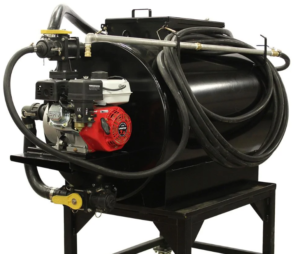In this blog post, we’ll uncover the signs of bacterial growth in Asphalt Emulsion and Liquid Petroleum Emulsion Asphalt Sealer. This way you can get rid of that Rotten Odor in your Emulsion Sealing Tank. We will also reveal the powerful solutions—bleach and biocide—that can remove the bacteria and odor from your asphalt sealer tank. We’ll also guide you through the step-by-step process of using these remedies effectively.
Detecting the Signs of Bacterial Growth:
- The Telltale Stench: One of the most unmistakable signs of bacterial growth in Asphalt Emulsion and Liquid Petroleum Emulsion Asphalt Sealer is the presence of a rotten egg smell. This foul odor is a result of hydrogen sulfide gas released by the bacteria as they metabolize, you will notice a Rotten Odor in your Emulsion Sealing Tank.
- Volume Overload: If you observe an unusual increase in the volume of your Asphalt Sealer, bacteria might be at work. Bacterial activity produces gases that cause the Asphalt Sealer to expand, leading to a rise in volume.
- Foaming Fiasco: Bacterial growth induces foaming within the Asphalt Sealer due to gas emission and agitation caused by bacterial movement.
- Floating White Specks: The appearance of white or light-colored pieces floating on the Asphalt Sealer surface signifies the formation of biofilms. These biofilms are conglomerations of bacteria bound together by an organic matrix.
The Dynamic Duo: Bleach and Biocide Solutions:
When confronted with bacterial growth in Asphalt Emulsion and Liquid Petroleum Emulsion Asphalt Sealer, the combination of bleach and biocide offers a formidable defense strategy.
Bleach Treatment:
- Add one gallon of bleach to every 1,000 gallons of Sealer.
- Agitate / Mix for a duration of one to two hours. This ensures thorough incorporation of the bleach.
Biocide Treatment:
- Add one gallon of biocide with every 2,000 gallons of Sealer.
- Agitate / Mix for a duration of one to two hours. This ensures thorough incorporation of the bleach.
Important Note: Never combine bleach and biocide simultaneously, as their interaction could yield undesirable outcomes.
Conclusion:
Bacterial growth in Asphalt Emulsion and Liquid Petroleum Emulsion Asphalt Sealer can lead to undesirable consequences, including foul odors, volume expansion, foam formation, and the appearance of floating white specks. To combat this challenge, the judicious use of bleach and biocide stands as an effective solution. By meticulously following the step-by-step process, you can successfully thwart bacterial growth and restore the vitality and aesthetics of your asphalt sealer.
